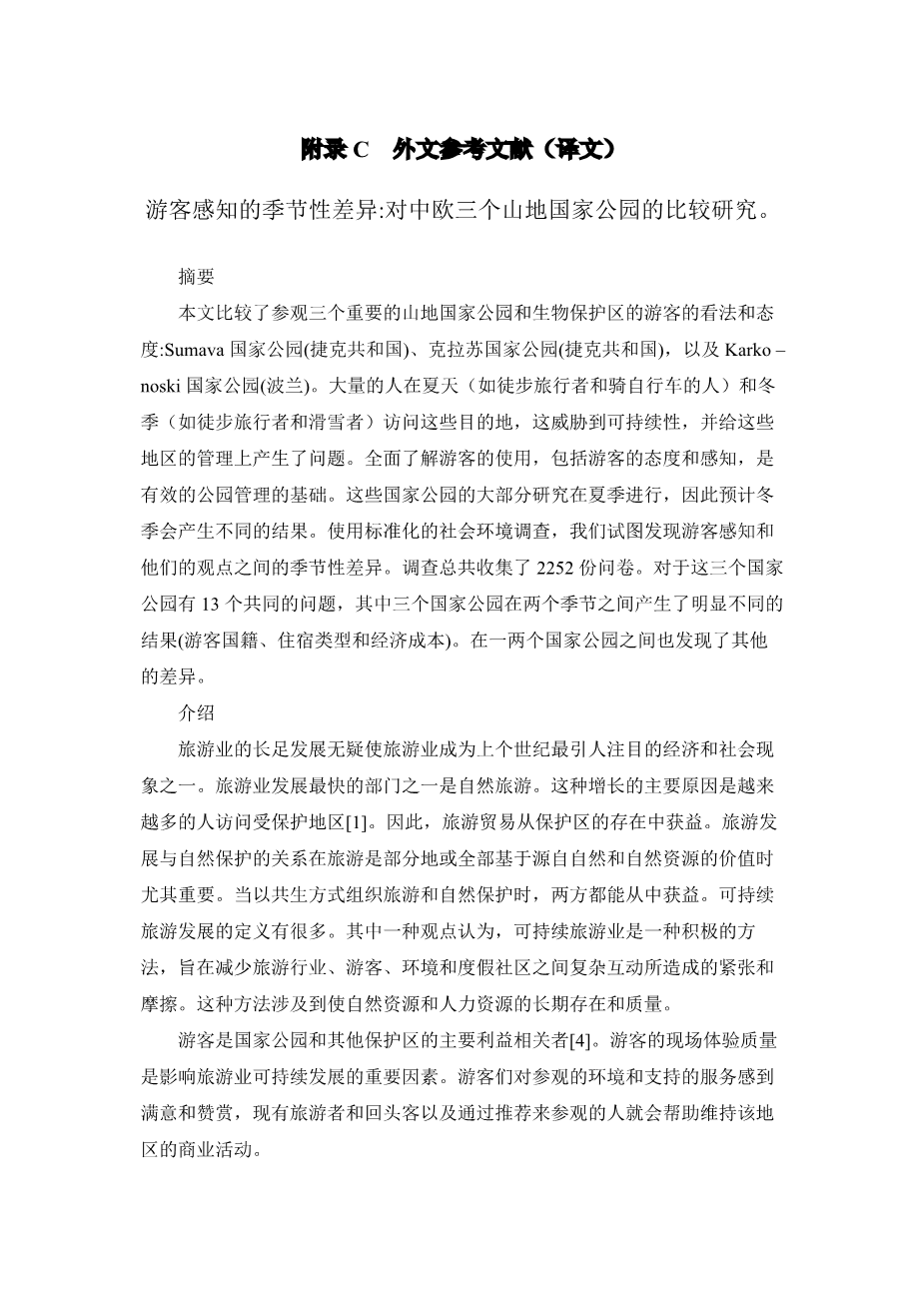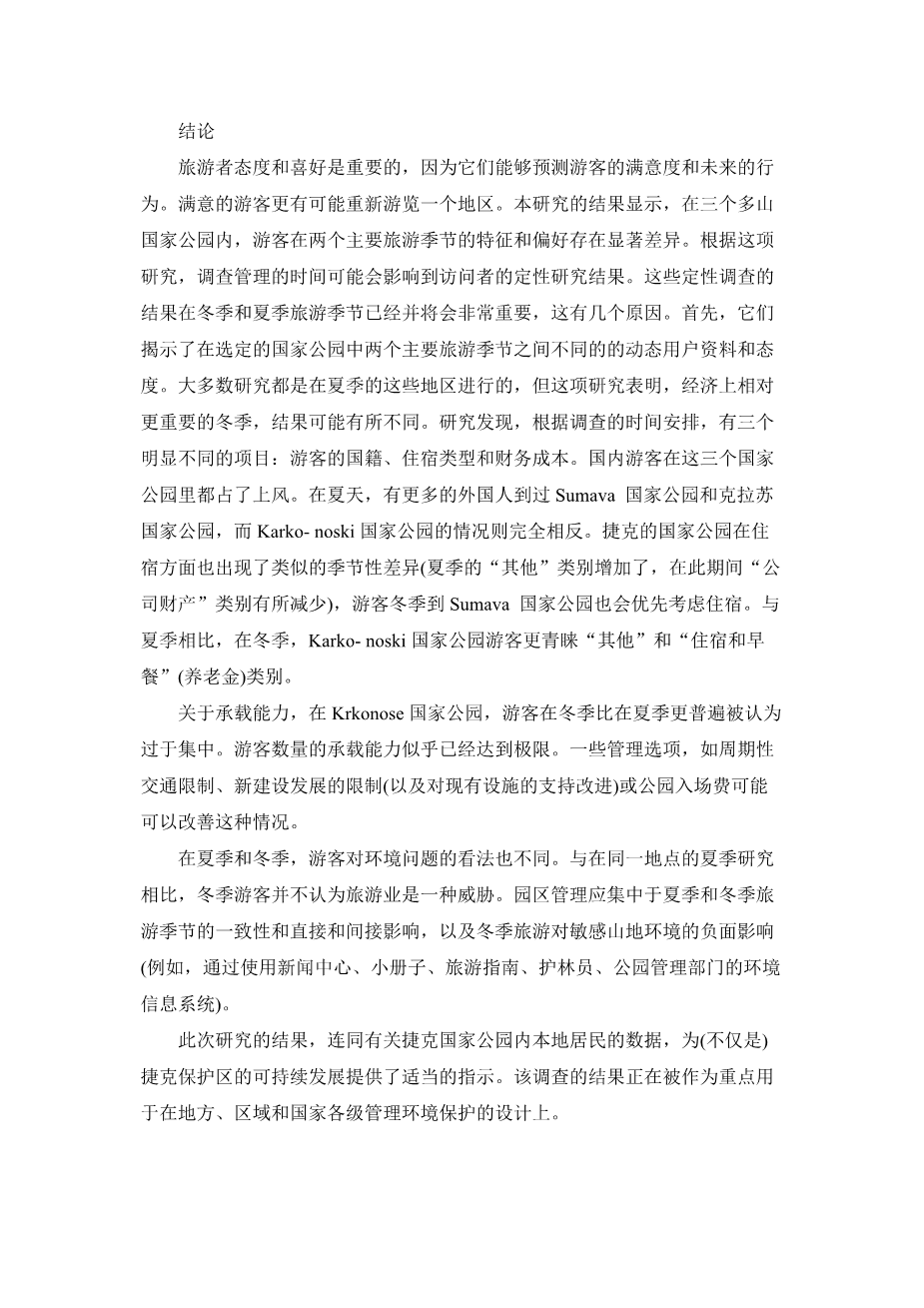Seasonal Differences in Visitor Perceptions: A Comparative Study of Three Mountainous National Parks in Central Europe.
ABSTRACT
This paper compares the views and attitudes of visitors to three key mountain national parks and Biosphere Reserves: Sumava National Park (Sumava NP, Czech Republic), Krkonose National Park (KRNAP, Czech Republic) and Karko- noski Park Narodowy (KPN, Poland). A large numbers of people visit these destinations both in the summer (e.g. hikers and cyclists) and in the winter (e.g. hikers and skiers), which threatens sustainability and creates problems regarding the management of these areas. A comprehensive understanding of visitor use, including visitors’ attitudes and percep- tions, is fundamental for effective park management. Most research in these national parks is carried out during the summer season, therefore different results in the winter season are expected. Using a standardised socio-environmental survey we attempt to find seasonal differences between visitors and their opinions. A total of 2252 questionnaires were gathered. There were 13 common questions for these three national parks, three of them yielded significantly different results between the two seasons (visitors’ nationality, type of accommodation and financial costs). Other differences were detected in one or two national parks.
Introduction
The substantial growth of tourism clearly makes the in- dustry one of the most remarkable economic and social phenomena of the past century. One of the fastest grow- ing subsectors of tourism is nature-based tourism. Much of this growth concerns increasing numbers of people visiting protected areas [1]. Thus, the tourist trade de- rives benefits from the existence of protected areas. The relationships between tourism development and nature conservation are particularly important when tourism is partly or totally based on values derived from nature and nature resources. Tourism and nature conservation can be in conflict or in symbiosis. Symbiosis is the case when tourism and nature conservation are organised in such a way that both these disciplines derive benefits from the relationship [2]. There are many definitions of sustainable tourism development. One of these states that sustainable tourism is a positive approach intended to reduce the tensions and frictions created by the complex interactions between the tourism industry, visitors, the environment and the communities which are host to holidaymakers. This approach involves working for the longer viability and quality of both natural and human resources [3].
Tourists are central stakeholders of national parks and other protected areas [4]. The quality of visitors’ on-site experience is an important factor influencing and under- lying much sustainable tourism. Tourists, who are satis- fied and appreciative of visited settings and support ser- vices, help sustain the business in the region both as ex- isting and repeat visitors and through referrals [5].
Conclusions
Tourists’ attitudes and preferences are important because they predict tourist satisfaction and future behaviour. Satisfied visitors are more likely to revisit an area. The results of this study show significant differences in char- acteristics and preferences of visitors in two main tourist seasons in three mountainous national parks. According to this study, the timing of the survey administration could affect the results of visitors’ qualitative research. These results of qualitative surveys in winter and sum- mer tourist seasons have been, and will be, very impor- tant for several reasons. First, they reveal various dy- namic user profiles and attitudes between two main tour- ist seasons in the selected national parks. Whereas most research is carried out during the summer season in these areas, this study demonstrates that the results from the relatively economically crucial winter season may be different. The research found three significantly different items depending on the timing of the survey: visitors’ nationality, type of accommodation and financial costs. Domestic tourists prevailed in all three national parks. More foreigners visited Sumava NP and KRNAP in summer than in winter, while the situation in KPN was strictly opposite. Both Czech national parks evinced similar seasonal differences in accommodation (an in- crease in the “Other” category in the summer season and a decrease in the “Company property” category in this period), visitors to Sumava NP also gave priority to ho- tels in the winter season. KPN visitors preferred the “Other” and “Bed and breakfast” (pension) categories in winter in comparison with the summer months. Winter visitors spent more money in comparison with summer tourists.
Concerning carrying capacity, in KRNAP, the feeling that tourism is too concentrated was more widely held by tourists in the winter season than in the summer season. The carrying capacity of visitor numbers seems to have nearly been reached. Some management options like periodic traffic limitations, restrictions of new construc- tion development (and supporting improvement of exist-
ing facilities) or park entrance fees could improve this situation.
Tourists also had different perceptions of environ- mental problems in the summer and winter seasons. Win- ter tourists did not see tourism as a threat, in contrast to summer research at the same site. Management of the park should focus on consistency and the direct and in- direct effects of summer and winter tourist seasons, as well as tourist awareness of the negative impacts of tour- ism on the sensitive mountain environment in winter (e.g. by using information centres, brochures, tourist guides, rangers, environmental information system of the park administrations).
Results from this study, together with data about local residents in Czech national parks,
剩余内容已隐藏,支付完成后下载完整资料


英语译文共 5 页,剩余内容已隐藏,支付完成后下载完整资料
资料编号:[468343],资料为PDF文档或Word文档,PDF文档可免费转换为Word
您可能感兴趣的文章
- COVID-19时期的旅游业和可持续发展:以西班牙为例外文翻译资料
- 农民相对剥夺感对乡村旅游可持续发展的影响机制外文翻译资料
- 校园大学生的旅行行为——以亚洲某乡村大学为例外文翻译资料
- 内容旅游与地方社区响应:鹫宫的“幸运之星”和“协作动漫旅游”外文翻译资料
- 基于符号互动理论的遗产旅游资源开发与重塑——以良渚古城遗址为例外文翻译资料
- 在TikTok上映射互联网名人:探索注意力、经济和可见性劳动力外文翻译资料
- 基于社区游客视角的环境责任行为的概念和度量外文翻译资料
- 温泉小镇的再造:维希的独特案例——副标题外文翻译资料
- 基于IP理念的桐乡丰子恺文化旅游开发研究外文翻译资料
- 特殊事件对旅游业的影响及其应对措施研究——新冠肺炎疫情对全球旅游业的影响及其应对措施外文翻译资料


